|
In this Issue...
- Upcoming IBNS Deadlines
- A Personal Note from the New Editor-in-Chief
- Member News
- Congratulations to the 2020 Travel Award Recipients!
- Trends in Behavioral Neuroscience
- Calling all Potential Guest Editors!
- A Final Farewell
Upcoming IBNS Deadlines
IBNS 29th Annual Meeting
June 2 - June 6, 2020, Glasgow, Scotland
#IBNS #IBNSconnect #IBNS2020
IBNS Preliminary Program
| February 1 |
Fellows, Outstanding Achievement Award and Early Career Award nominations due
Click here for details on these awards and the nomination process.
|
| February 3 |
Abstract Submissions Due (Form opens Oct. 1, 2019)
2020 Abstract Form
|
| February 3 |
Early Discounted Registration Ends (Form opens Oct. 1, 2019)
Registration Form
|
| Feb 14 |
Final date to submit an Abstract Due (poster only)
|
Should you need any assistance, please contact the IBNS office at [email protected] or call us at +01 830-796-9393. Our office hours are 8:00 am - 5:00 pm Central time, Monday through Friday.
Back to Top
A personal note from the new Editor-in-Chief
By Don McEachron, Ph.D., Editor-in-Chief
Drexel University, USA
 Traveling back to Scotland. I cannot describe how personally pleased I was to discover that the annual meeting in 2020 for the International Behavioral Neuroscience Society was to be held in Glasgow, Scotland. I've been to Scotland once before in 2011 when I was delivering a talk at a conference in Belfast, Northern Ireland. At the time, none of my family had ever visited either Scotland or Ireland and this seemed to be an ideal time to rectify the situation. Since my wife is an O'Donnell and I am a McEachron (I am descended from Donald McEachron born on Islay Island, Argyll, Scotland in ~1706), it seemed fitting that we come to our ancestral countries and introduce my son Christopher to his heritage. Traveling back to Scotland. I cannot describe how personally pleased I was to discover that the annual meeting in 2020 for the International Behavioral Neuroscience Society was to be held in Glasgow, Scotland. I've been to Scotland once before in 2011 when I was delivering a talk at a conference in Belfast, Northern Ireland. At the time, none of my family had ever visited either Scotland or Ireland and this seemed to be an ideal time to rectify the situation. Since my wife is an O'Donnell and I am a McEachron (I am descended from Donald McEachron born on Islay Island, Argyll, Scotland in ~1706), it seemed fitting that we come to our ancestral countries and introduce my son Christopher to his heritage.
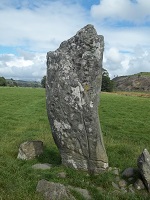 The trip far exceeded even my highest expectations. Scotland is a land steeped in both beauty and history. Although I do have to admit that it took a bit before I could get used driving on the left side of the road. I still remember trying to wrap my head - and my driving - around single track roads and 'passing places'. My instinctive response to move to the right when encountering another vehicle did not go over particularly well and I am rather glad that I was not quite able to understand what the other driver was saying during one of those awkward encounters. The trip far exceeded even my highest expectations. Scotland is a land steeped in both beauty and history. Although I do have to admit that it took a bit before I could get used driving on the left side of the road. I still remember trying to wrap my head - and my driving - around single track roads and 'passing places'. My instinctive response to move to the right when encountering another vehicle did not go over particularly well and I am rather glad that I was not quite able to understand what the other driver was saying during one of those awkward encounters.
Still, even for person who lives in as historical a place as Philadelphia, the depth of the past in Scotland took my breath away. To be able to walk up to one of the standing stones and sense the continuity of human history back for thousands of year (instead of the hundreds in Philly) was humbling.
So, I have some advice to you all. Enjoy the conference and your colleagues but do not forget to get out and immersive yourself in both the beauty and the history of this incredible country.
Tours and Sites as Part of the 2020 Annual Meeting - Edinburgh Castle
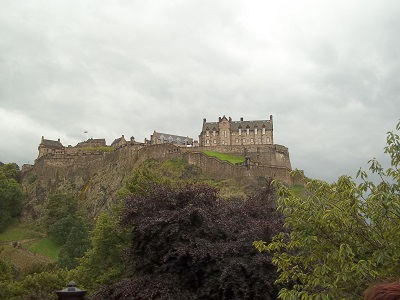
Edinburgh Castle is an imposing structure built on a formation of rock called Castle Rock which formed as a result of volcanic eruption some 340 million years ago. Overlooking the city of Edinburgh and the surrounding countryside, the site has been used for military purposes since the Iron Age. The first castle known to exist on the rock was referred to as "The Castle of the Maidens" and according to legend, the castle was a shrine to the "Nine Maidens" one of whom was Morgan le Fay, the sorceress of Arthurian legend.
Although Castle rock has been a military base and royal residence for centuries, the current Edinburgh Castle was built during the 12th century by David I, son of St. Margaret of Scotland. The Castle defenses have evolved over the years. One of the greatest medieval cannons ever made, Mons Meg, was given to King James II in 1457. The Half Moon Battery, built after the Lang Siege of 1573, was armed for some 200 years by bronze guns known as the Seven Sisters and six more guns defend the Argyle Battery looking northward.
Edinburgh Castle is thought to be the most besieged location in Great Britain. A brief look at the history of the Castle certainly supports this claim. The current Castle was built in 1130 C.E. This Castle was captured by Edward I of England in 1296 C.E. It was then recaptured by the Scots in 1313 C.E., recaptured again by the English in 1334 C.E., and recaptured by the Scots in 1341 C.E. In 1571, following many years of civil strife, the Castle was held by supporters of Queen Mary (led by Secretary Grange) against the rule of the new regent, the Earl of Lennox who supported the infant King James VI. In 1572, the Earl captured the town of Edinburgh and with the assistance of Elizabeth I, negotiated a truce which lasted until January 1, 1573. At that point, the forces of King James VI led by a new Regent – the Earl of Morton – lay siege to the Castle which led to its eventual surrender. This episode has come down through history as the Lang Siege. The damage to the Castle led to rebuilding in 1578 C.E.
However, this did not end continual strife surrounding Edinburgh Castle. In 1650 C.E., Oliver Cromwell captured Edinburgh Castle and executed Charles I, the last Scottish monarch to inhabit the Castle. Then, in 1689 C. E., members of the first Jacobite Rising attempt – and fail – to recapture the Castle. Finally, in 1745 C.E., Bonnie Prince Charlie and members of the fifth Jacobite Rising again attempt - and again fail - to recapture the Castle. In between these major episodes, other attempts to recapture the castle were undertaken. During the Rising of 1715, a Jacobite force failed apparently due to extraordinarily poor planning. The latter they brought to scale the ramparts turned out to be too short.
Some rather interesting - and unusual - facts and legends about the Castle include:
St. Margaret's Chapel. The Chapel is one of the oldest buildings in Scotland, having been built in 1130 C.E. It was the only structure to be spared destruction by Robert the Bruce when he captured the Castle in 1313 -14.
The Witches' Well. There is a small water fountain, known as The Witches' Well, at the edge of the Castle Esplanade - on the north wall of the Tartan Weaving Mill - that marks the spot where hundreds of women accused of witchcraft were burned at the stake between the 15th and 18th centuries. A truly dark chapter in the history of the Castle and Scotland.
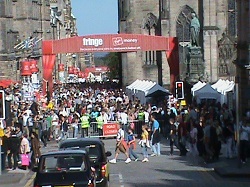
The Lone Piper. Like many older structures, the Castle is reputed to be haunted. In this case, the story goes that tunnels were discovered underneath the Royal Mile – the road that leads up to the Castle – and a young piper was sent down to investigate and told to play the pipes as he walked along so that people above could track him and thus map the tunnels. About halfway along the route, the playing suddenly stopped. A search party was sent down to retrieve the boy but neither he nor his body were ever found. It is said that the music from the pipes can still be heard under both the Castle and the Royal Mile.
Final Examinations for the University of Edinburgh. It is a legend among the University of Edinburgh students that any student of the University who passes through the Castle gates will fail their final examinations. As a result, many university students will not visit the Castle during their time at the University, preferring to be safe than sorry.
Sources:
Edinburgh Castle History - The Lang Siege (http://www.edinburgh-history.co.uk/lang-siege.html)
Edinburgh Castle - History of the Castle (https://www.edinburghcastle.scot/the-castle/history)
History of Edinburgh Castle (http://www.edinburghcastle.co.uk/history/)
7 Facts about Edinburgh Castle (https://www.edinburghfirst.co.uk/our-blog/7-facts-about-edinburgh-castle/)
10 Facts You May Not Know About Edinburgh Castle (https://www.scotsman.com/lifestyle-2-15039/10-facts-you-may-not-know-about-edinburgh-castle-1-3896061)
Back to Top
Member News
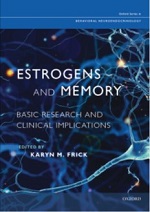 IBNS member Dr. Karyn M. Frick has edited a new book entitled Estrogens and Memory: Basic Research and Clinical Implications published by Oxford University Press in which several IBNS members have written chapters. The volume provides a compendium of cutting-edge basic and clinical research describing the ways in which estrogens regulate memory in a variety of species. Chapters are written by leading experts whose work is on the forefront of this exciting field. The book is organized into three sections focusing on: 1) effects of estrogens on the hippocampus and other brain regions central to memory, 2) effects of estrogens on memory and related cognitive processes throughout the lifespan, and 3) translational implications of estrogenic regulation of memory for aging and disease. This book gives an insider’s perspective on how hormonal regulation of brain function influences cognition and provides a one-stop reference for those interested in learning about the effects of estrogens on memory and the resulting implications for mental health. IBNS member Dr. Karyn M. Frick has edited a new book entitled Estrogens and Memory: Basic Research and Clinical Implications published by Oxford University Press in which several IBNS members have written chapters. The volume provides a compendium of cutting-edge basic and clinical research describing the ways in which estrogens regulate memory in a variety of species. Chapters are written by leading experts whose work is on the forefront of this exciting field. The book is organized into three sections focusing on: 1) effects of estrogens on the hippocampus and other brain regions central to memory, 2) effects of estrogens on memory and related cognitive processes throughout the lifespan, and 3) translational implications of estrogenic regulation of memory for aging and disease. This book gives an insider’s perspective on how hormonal regulation of brain function influences cognition and provides a one-stop reference for those interested in learning about the effects of estrogens on memory and the resulting implications for mental health.
 Congratulations to Dr. Stephen Kent, Head of the School of Psychology and Public Health and his colleagues from the Department of Psychology at La Trobe University for climbing 49 places to 187 in the latest Times Higher Education World Subject University Rankings. The School houses the Department of Psychology and Counseling, the Department of Public Health, the Olga Tennison Autism Research Centre, Bouverie Centre, Centre for Alcohol Policy Research, Australian Research Centre in Sex, Health and Society, and the Centre for Health Communication and Participation. The increase in ranking endorses La Trobe University as a world leader in Psychology research and teaching. Read more here (https://www.latrobe.edu.au/news/articles/2019/release/la-trobe-psychology-rises-in-ranking). Congratulations to Dr. Stephen Kent, Head of the School of Psychology and Public Health and his colleagues from the Department of Psychology at La Trobe University for climbing 49 places to 187 in the latest Times Higher Education World Subject University Rankings. The School houses the Department of Psychology and Counseling, the Department of Public Health, the Olga Tennison Autism Research Centre, Bouverie Centre, Centre for Alcohol Policy Research, Australian Research Centre in Sex, Health and Society, and the Centre for Health Communication and Participation. The increase in ranking endorses La Trobe University as a world leader in Psychology research and teaching. Read more here (https://www.latrobe.edu.au/news/articles/2019/release/la-trobe-psychology-rises-in-ranking).
 Dr. Stan Floresco, Professor at The University of British Columbia, received the 2019 Daniel H Efron Research Award from the American College of Neuropsychopharmacology (ACNP). This award recognizes researchers whose work emphasizes the interface between basic and clinical research, and contributes to advancing the field of neuropsychopharmacology. Dr. Floresco obtained his Ph.D. in 2000 from the University of British Columbia and continued post-doctoral studies at the University of Pittsburgh through 2003. His research interests focus on the neural circuits that facilitate different forms of learning and cognition using rodents as a model system. We congratulate Dr. Floresco on receiving this prestigious award. Read more here (https://psych.ubc.ca/news/stan-floresco-awarded-2019-daniel-h-efron-research-award/) Dr. Stan Floresco, Professor at The University of British Columbia, received the 2019 Daniel H Efron Research Award from the American College of Neuropsychopharmacology (ACNP). This award recognizes researchers whose work emphasizes the interface between basic and clinical research, and contributes to advancing the field of neuropsychopharmacology. Dr. Floresco obtained his Ph.D. in 2000 from the University of British Columbia and continued post-doctoral studies at the University of Pittsburgh through 2003. His research interests focus on the neural circuits that facilitate different forms of learning and cognition using rodents as a model system. We congratulate Dr. Floresco on receiving this prestigious award. Read more here (https://psych.ubc.ca/news/stan-floresco-awarded-2019-daniel-h-efron-research-award/)
 We congratulate Daphne Ling, graduate student at The University of British Columbia, for her recent book chapter publication. A full citation is below: We congratulate Daphne Ling, graduate student at The University of British Columbia, for her recent book chapter publication. A full citation is below:
Diamond, A., & Ling, D. S. (2019). Review of the evidence on, and fundamental questions about, efforts to improve executive functions, including working memory. In J. Novick, M.F. Bunting, M.R. Dougherty & R. W. Engle (Eds.), Cognitive and Working Memory Training: Perspectives from Psychology, Neuroscience, and Human Development, (pp.143-431). New York, NY: Oxford University Press. ISBN:978-0199974467
 In recognition of his groundbreaking research and contributions to society, Dr. Kent Berridge received an Honorary Doctorate of Science from the University of Sussex. Dr. Berridge is currently the James Olds Distinguished University Professor of Psychology and Neuroscience at the University of Michigan as well as a Visiting Professor in Psychology at Sussex. His research focuses on how sensations of pleasure and desire are generated in the brain and has wide applicability to numerous neural conditions. Please join us in congratulating Dr. Berridge on receiving this prestigious honor. Read more here (https://www.sussex.ac.uk/news/features/people?id=50833) In recognition of his groundbreaking research and contributions to society, Dr. Kent Berridge received an Honorary Doctorate of Science from the University of Sussex. Dr. Berridge is currently the James Olds Distinguished University Professor of Psychology and Neuroscience at the University of Michigan as well as a Visiting Professor in Psychology at Sussex. His research focuses on how sensations of pleasure and desire are generated in the brain and has wide applicability to numerous neural conditions. Please join us in congratulating Dr. Berridge on receiving this prestigious honor. Read more here (https://www.sussex.ac.uk/news/features/people?id=50833)
Back to Top
Congratulations to the 2020 Travel Award Recipients!
We are pleased to announce the recipients (listed alphabetically) of the IBNS Travel Awards for the 2020 meeting in Glasgow, Scotland, UK. Award winners will receive a cash award, certificate, and waiver of registration fees. Travel awardees will present their research orally and in a poster session. Travel awards are funded by the IBNS and its members. Additional funding was provided by Plexon.
Many deserving students remain – we could only fund 20% of the 106 travel applications. Please consider donating to help a student or post-doctoral fellow attend the annual meeting. Click here if you would like the opportunity to support IBNS travel awards!
Plexon Postdoctoral Award
Holly Hunsberger, Columbia University, USA
Postdoctoral Awards
Jennifer Fragale, Rutgers University, USA
Katherine McMurray, University of Cincinnati, USA
Agnieszka Potasiewicz, Polish Academy of Sciences, Poland
Jennifer Tuscher, University of Alabama at Birmingham, USA
Graduate Awards
Alice Abbondanza, FGU - Institute of Physiology CAS, Czech Republic
Debra Bercovici, University of British Columbia, Canada
Elizabeth Berg, University of California Davis, USA
Dionnet Bhatti, Harvard University, USA
Alexandre Guerin, The Florey Institute of Neuroscience and Mental Health, Australia
Nicole Jenni, University of British Columbia, Canada
Najmeh Katebi, Tehran University of Medical Sciences, Iran (Islamic Republic of)
David Keller, Semmelweis University, Hungary
Judith Kreutzmann, Otto-von-Guericke University, Germany
Stacia Lewandowski, Drexel University, USA
Kamakshi Mehta, All India Institute of Medical Sciences, India
Laura Milton, Monash University, Australia
Rebecca Ravenelle, City University of New York, USA
James Ryan, Weill Cornell Medicine, USA
Kevin Uribe, The University of Texas at El Paso, USA
Krista Wahlstrom, University of Iowa, USA
Undergraduate Awards
Yasmin Padovan-Hernandez, University of Florida, USA
Congratulations to all!
Back to Top
Trends in Behavioral Neuroscience
Brain Interconnectivity and Cerebellar Function in Behavioral Decision-Making
Using whole-brain volumetric calcium imaging, researchers at The Rockefeller University investigated how decision-making occurs in a motor behavior using larval zebrafish. Employing an operant conditioning paradigm, the researchers uncovered certain recurring global dynamic patterns preceding behaviors potentially indicative of executive decision-making. Specifically, the authors report that the granular layer of the cerebellum displayed a significantly predictive change in activity some 10 seconds before the behavior was expressed. The direction of the turn was predicted by the difference in neuroactivity between ipsilateral and contralateral hemispheres. The study highlights both the role of the cerebellum in decision-making as well as the involvement of multiple neural regions in even those tasks which might otherwise be deemed simple and straight-forward.
Lin, Q., Manley, J., Helmriech, M., Schier, A. Nöbauer, T. and Vaziri, A. (2020) Cerebellar Neurodynamics Predict Decision Timing and Outcome on the Single-Trial Level. Cell Published: January 16, 2020 DOI:https://doi.org/10.1016/j.cell.2019.12.018
The Effects of Soybean Oil on Hypothalamic Gene Expression and Function
Soybean oil consumption is widespread and has greatly increased in recent years. Although the oil is known to be linked to both obesity and diabetes, researchers at the University of California, Riverside were interested in the effects the oil might have on brain functions and more specifically, hypothalamic gene expression. Male mice were fed one of there isocaloric, high-fat diets: 1) a diet high in conventional soybean oil (high linoleic acid (LA) content); 2) a diet high in genetically modified soybean oil (low linoleic acid (LA) content); and 3) a diet high in coconut oil (no linoleic acid (LA) content). The two soybean oil diets resulted in changes hypothalamic gene expression, albeit not quite the same, whereas the coconut oil diet had negligible effects when compared with a low-fact control. Genes that appear to be dysregulated were associated with inflammation, neuroendocrine and neurochemical signaling. One neurochemical effected by the soybean oil diet was oxytocin but upwards of 100 genes were altered in some manner.
The authors discuss the possible ramifications of their findings on public health.
Deol, P., Kozlova, E., Valdez, M. Ho, C. Yang, E.-W., Richardson, H., Gonzalez, G., Truong, E., Reid, J., Valdez, J., Deans, J.R., Martinez-Lomeli, J., Evans, J.R., Jiang, T., Sladek, F.M. & Curras-Collazo, M.C. (2020). Dysregulation of Hypothalamic Gene Expression and the Oxytocinergic System by Soybean Oil Diets in Male Mice. Endocrinology, bqz044, https://doi.org/10.1210/endocr/bqz044
Back to Top
Calling all Potential Guest Editors!
The IBNS Newsletter is searching for volunteers to serve as guest editors during 2020. This is a wonderful chance to make friends and influence your colleagues, so do not let this opportunity pass you by! If you are interested, please contact the IBNS Central Office ([email protected]) or the Editor-in-Chief, Don McEachron ([email protected]). Please help to support the IBNS community of scholars by serving as the guest editor for a newsletter in 2020.
Back to Top
A Final Farewell
It is with great sadness that I report the passing of a giant in the field of neuroendocrinology. Dr. Bruce S. McEwen died on January 2, 2020 at the age of 81 after a brief illness. Bruce’s research on the interaction of stress hormones and brain function were ground-breaking and the his contributions, along those of his colleagues, on the study of brain plasticity during aging fundamentally changed our perception of brain development. Bruce was recognized by his peers and the scientific community with many accolades and awards, including the Pasarow Neuropsychiatry Award, the Ipsen Fondation Neuroplasticity and Endocrine Regulation Prizes, the Scolnick Prize in Neuroscience( McGovern Institute of MIT), and the William James Lifetime Achievement Award for Basic Research presented in honor of the 25th Anniversary of American Psychological Society. Bruce was also an elected member of the National Academy of Sciences, the National Academy of Medicine, and the American Society of Arts and Sciences. For more information about the life of Dr. Bruce S. McEwen, see: https://www.rockefeller.edu/news/27135-neuroscientist-bruce-mcewen-studied-impact-stress-brain-died/
Dr. McEwen’s family has requested that, in lieu of flowers, donations be made to the Bruce S. McEwen Fund at Rockefeller University at: https://giveandjoin.rockefeller.edu/donate
Back to Top
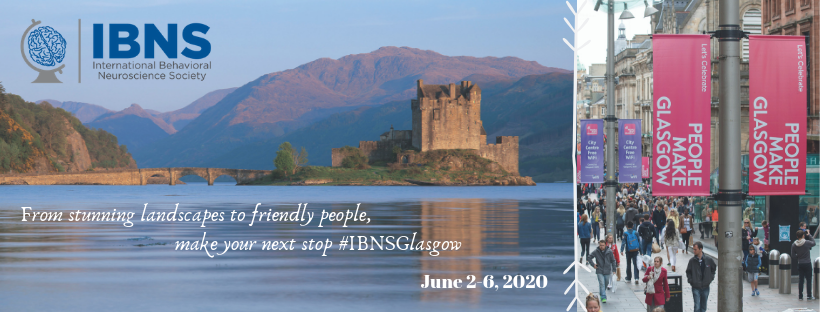
Back to Top
|